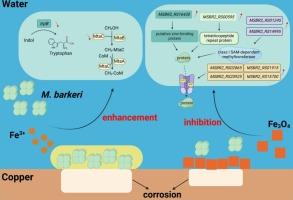Mechanistic investigation of ferric ion and ferriferous oxide on M. barkeri-mediated copper corrosion
IF 6.3
2区 工程技术
Q1 ENGINEERING, CHEMICAL
引用次数: 0
Abstract
Methanosarcina barkeri (M. barkeri) can cause microbiologically influenced corrosion (MIC) of copper in heat exchangers, where ferric ion (Fe3+) and ferriferous oxide (Fe3O4) also exist due to the corrosion of iron pipes with flowing water. It is worth noting that M. barkeri can reduce Fe3+ to Fe2+ or Fe, which may exhibit an unknown effect on copper corrosion. In this study, the molecular mechanism of copper corrosion by M. barkeri with Fe3+ and Fe3O4 was explored. In the presence of Fe3+, the corrosion was enhanced by 82.5 %, and M. barkeri and Fe3+ exhibited a synergistic effect on copper corrosion. It is attributed to that Fe3+ oxidized the copper and promoted the growth of M. barkeri and biofilm formation, thus promoting corrosion. Moreover, the corrosion by M. barkeri with Fe3O4 increased by only 27.7 %, and M. barkeri and Fe3O4 exhibited an antagonistic effect on the corrosion. Fe3O4 covered the coupon surface, which reduced the contact between the cells and the coupon, and thus inhibited electrochemical corrosion. This study provides new insights for methanogens-induced MIC, and also has far-reaching implication for the mitigation of MIC in heat exchangers.

铁离子和氧化亚铁对巴氏菌介导的铜腐蚀的机理研究
由于流水对铁管的腐蚀,铁离子(Fe3+)和铁氧化物(Fe3O4)也存在于热交换器中。值得注意的是,M. barkeri 能将 Fe3+ 还原成 Fe2+ 或 Fe,这可能会对铜腐蚀产生未知的影响。本研究探讨了树皮蝇与 Fe3+ 和 Fe3O4 对铜腐蚀的分子机理。在有 Fe3+ 存在的情况下,铜的腐蚀增强了 82.5%,M. barkeri 和 Fe3+ 对铜的腐蚀表现出协同效应。这是因为 Fe3+ 氧化了铜,促进了巴氏菌的生长和生物膜的形成,从而促进了腐蚀。此外,Fe3O4 对巴氏杆菌的腐蚀只增加了 27.7%,巴氏杆菌和 Fe3O4 对腐蚀的影响是拮抗的。Fe3O4 覆盖了试样表面,减少了细胞与试样之间的接触,从而抑制了电化学腐蚀。这项研究为甲烷菌诱导的 MIC 提供了新的见解,同时对缓解热交换器中的 MIC 也具有深远的意义。
本文章由计算机程序翻译,如有差异,请以英文原文为准。
求助全文
约1分钟内获得全文
求助全文
来源期刊

Journal of water process engineering
Biochemistry, Genetics and Molecular Biology-Biotechnology
CiteScore
10.70
自引率
8.60%
发文量
846
审稿时长
24 days
期刊介绍:
The Journal of Water Process Engineering aims to publish refereed, high-quality research papers with significant novelty and impact in all areas of the engineering of water and wastewater processing . Papers on advanced and novel treatment processes and technologies are particularly welcome. The Journal considers papers in areas such as nanotechnology and biotechnology applications in water, novel oxidation and separation processes, membrane processes (except those for desalination) , catalytic processes for the removal of water contaminants, sustainable processes, water reuse and recycling, water use and wastewater minimization, integrated/hybrid technology, process modeling of water treatment and novel treatment processes. Submissions on the subject of adsorbents, including standard measurements of adsorption kinetics and equilibrium will only be considered if there is a genuine case for novelty and contribution, for example highly novel, sustainable adsorbents and their use: papers on activated carbon-type materials derived from natural matter, or surfactant-modified clays and related minerals, would not fulfil this criterion. The Journal particularly welcomes contributions involving environmentally, economically and socially sustainable technology for water treatment, including those which are energy-efficient, with minimal or no chemical consumption, and capable of water recycling and reuse that minimizes the direct disposal of wastewater to the aquatic environment. Papers that describe novel ideas for solving issues related to water quality and availability are also welcome, as are those that show the transfer of techniques from other disciplines. The Journal will consider papers dealing with processes for various water matrices including drinking water (except desalination), domestic, urban and industrial wastewaters, in addition to their residues. It is expected that the journal will be of particular relevance to chemical and process engineers working in the field. The Journal welcomes Full Text papers, Short Communications, State-of-the-Art Reviews and Letters to Editors and Case Studies
 求助内容:
求助内容: 应助结果提醒方式:
应助结果提醒方式:


